From its earliest days, the South Australian government applied customs duty (charges levied on all foreign and domestic imported goods) as a means of raising money to keep the colony financially solvent. As the colony’s largest port, and the destination of the vast majority of its inbound shipping, Port Adelaide hosted four different customs houses between 1838 and 1987. Each customs house was a relatively large structure that accommodated offices, one or more storage areas for imported goods, the office (and sometime residence) of the Port’s Customs Officer, and a ‘long room’ where the majority of transactions between customs officials and merchants took place. The last and largest of these buildings, built in 1880, still stands at the corner of Commercial Road and North Parade. Its immediate predecessor, built on Commercial Road in 1860, is located a short distance away and currently serves as the Port Adelaide Visitor Information Centre.
Port Creek Settlement: The First Customs House
South Australia’s first customs house was built on a low sand hill among mangroves at the Port Creek Settlement (also known as ‘Port Misery’). The Port Creek Settlement was the colony’s initial landing site and established a short distance upriver from the present-day location of Port Adelaide. Very little historical information exists regarding the appearance and composition of the first customs house, which was generally described as an ‘unpretentious weatherboard building, a little structure on wooden blocks, with a narrow verandah in front’. In addition to its official function, the structure also served as living quarters for the colony’s first Customs Officer, Captain Thomas Lipson, and his family. Two pre-fabricated iron buildings similar in appearance to Nissen Huts were erected on pine blocks a short distance from the customs house. At least one of these structures functioned as a bonded store, and would have been used to accommodate imported goods inspected and approved by customs officials.
Second Port Adelaide Customs House
The Port Creek Settlement was plagued by several factors—foremost among them insufficient water depth and periodic episodes of intense flooding—that made it unsuitable as a landing site. Consequently, South Australia’s second governor, George Gawler, advocated that the port be moved to a new site at the confluence of the Port River and North Arm. Lack of money and resources curtailed the North Arm plan, and Port Adelaide was instead moved to its present location in 1840.
A new customs house was erected the same year on the west bank of a creek located within the footprint of what is now Commercial Road. This tidal stream, dubbed ‘Custom-House Creek’, was eventually shored up with wooden sheet piles along its western side, and served as a loading area for barges, lighters and other small, shallow-drafted vessels. It was also a de facto boat basin for the customs inspection vessel operated by Sir Robert Richard Torrens during his tenure as Collector of Customs (1840-1853). A simple wooden footbridge—also built in 1840—spanned the creek and connected the customs house and adjacent Queen’s Wharf with McLaren Wharf and the South Australian Company’s warehouse.
The customs house itself was a two-storey rectangular structure constructed primarily of timber. Like its predecessor at the Port Creek Settlement, it functioned as a storehouse and residence for the Collector of Customs in addition to its primary role as the centre of operations for customs officials. It was located within the government reserve, a riverfront allotment that included Queen’s Wharf, holding sheds, and a bond store. In 1848, a post office and police station were added to the reserve, and several additional offices associated with maritime affairs were constructed in the 1850s. A new customs house was constructed in 1860 (see below), and the former customs house appears to have been used as a residence by James C. Hawker (the Port’s Comptroller of Customs) until 1862. Although at one time nominated to serve as the Port’s casualty hospital, it was subsequently utilised in a succession of temporary roles, including as the Telegraph Office, waterworks, Port Adelaide Institute, and headquarters for the Engineer Surveyor and Examiner of Mates. It was demolished to make way for the fourth and final customs house in 1878.
Third Port Adelaide Customs House
Construction commenced on Port Adelaide’s third customs house in November 1859. Unlike its predecessors, the new building was integrated within a larger complex that included the Port’s new courthouse and police station. It was also the first customs house to be built of solid stone, an attribute indicative of South Australia’s growing prosperity during the latter half of the nineteenth century. The courthouse was the central feature of the complex, and the largest structure. It fronted Commercial Road and was flanked to the south by the police station and to the north by the customs house.
Messrs. English and Brown were chosen to construct the building. Their work was overseen by T.A. Abbott, the Supervisor of Works for the designer, Colonial Architect Edward Hamilton. All buildings in the complex were constructed in Victorian Italianate style, and featured an arched façade and solid plinths. Because it was constructed on recently reclaimed land, the building’s foundations comprised a raft of red gum timbers embedded in lime concrete. Land reclamation activities continued after construction concluded, with the result that the ground floor is presently below street level.
The customs house wing comprised a 34-foot (10.4-metre) high two-storey structure, the ground floor of which consisted of an open-plan long room measuring 44 feet, 10 inches (13.7 metres) by 23 feet, 10 inches (7.3 metres). An office for the Collector of Customs measuring 14 feet, 6 inches (4.5 metres) square was located immediately adjacent to the long room, and featured a vestibule and staircase to upstairs offices. A gauging room and fireproof room completed the ground floor arrangement. The four offices located on the first floor each measured 20 by 18 feet (6.1 by 5.5 metres) and were complimented by a waiting room 19 feet, 3 inches (5.9 metres) long by 9 feet (2.7 metres) wide. All of the building’s fixtures were manufactured from Sydney cedar, and the long room was ‘handsomely fitted up with counters [and] desks’ for customs officials. Additional desks were also provided for public use.
Essentially completed by the end of October 1860, the customs house opened for business the following month. The entire government complex cost approximately £7 500 to build, and was celebrated in the local media for being a ‘conspicuous and decidedly ornamental addition to the Port’. Following construction of the fourth and final Port Adelaide customs house in the late 1870s, and opening of a new courthouse in 1882, the entire government building transferred to police control. Government offices associated with maritime affairs, such as the Navigation and Lighthouse Service and Transport Workers Registration Office, operated from the building at various times but it was primarily reserved for police use. The police station was moved to modern premises in the early 1990s, and the government building subsequently underwent several years of renovation and restoration. It officially reopened as the Port Adelaide Visitor Information Centre on 9 November 1997.
Fourth Port Adelaide Customs House
Construction of Port Adelaide’s fourth customs house commenced in 1878, following demolition of the timber customs house established on the same spot in 1840. Initially known as the ‘Government Offices’, it was designed by Colonial Architect George Thomas Light, and built on contract by Messrs. Williams & Cleave at a cost of £11 102. The two-storey building was designed in Victorian Italianate style and constructed from Dry Creek bluestone with Sydney white freestone dressings. Like its immediate predecessor, it was erected atop timber footings embedded in reclaimed land created during the 1860s. On account of its robust construction and 70-foot (21.3-metre) high observation tower, the Government Offices complex was—and continues to be—one of the most prominent public buildings in Port Adelaide.
Originally intended for use of the Mercantile Marine and Marine Board, the Government Offices instead initially accommodated the Marine Board and Customs Department. The Marine Board occupied the building’s first floor, while the customs house comprised the entire ground level. As with the 1860 customs house, the majority of the new structure consisted of a long room where customs business was transacted. In 1885, an improved long room of significantly greater size was constructed on the south side of the building adjacent to the Port Adelaide Institute.
As the amount of shipping entering Port Adelaide steadily increased during the latter half of the nineteenth century, the need arose for expansion of existing customs facilities. Consequently, a ground floor extension was added to the Government Offices building in 1890. It stretched across a former laneway between the customs house and Port Adelaide Institute and physically connected both structures. By the turn-of-the-century, a second level was added to the extension, and in 1901 the Customs Department took possession of the entire Government Offices building.
The Customs Department’s need for additional space continued unabated, however, and by the early 1950s it was renting rooms in the building of its next door neighbour, the Port Adelaide Institute. Following that organisation’s removal to new premises on St. Vincent Street in 1959, the Customs Department purchased and occupied the entirety of the old Institute building. In subsequent years, the interior of the Institute building was remodelled and internal access between it and the customs house created. The Customs Department occupied both structures until 1987, when it moved into a modern office block near the Portland Canal development. Since that time, the Government Offices building has been vacant, and has gradually fallen into disrepair. In May 2013, a 4-kilogram chunk of masonry fell from the building, prompting calls from the Port Adelaide community for its repair and restoration. Repair to the structure’s stonework and painting of its façade commenced in October 2013 as part of a State Government building restoration program.


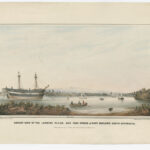

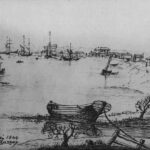
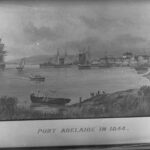
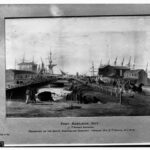
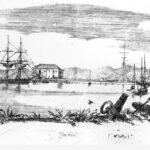
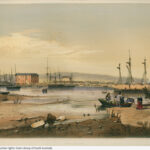
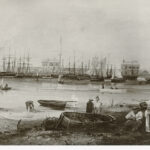
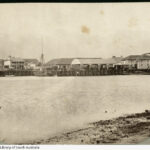
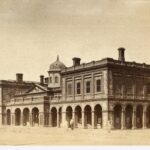
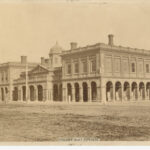
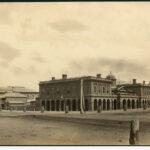
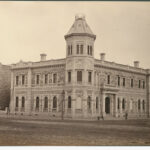
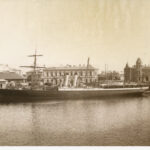
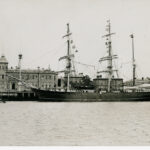
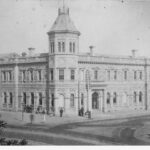
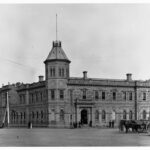
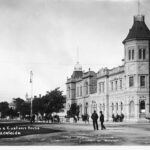
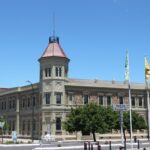
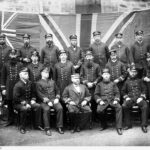
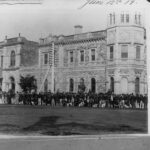

Comments
2 responses to “Customs Houses of Port Adelaide”
There is no place called the Portland Canal. It’s name was ‘The Old Port Canal’ which is adjacent to the area of the city known as Portland.
The Port Adelaide Institute was compelled by the Commonwealth to relocate as the old Institute was compulsorily acquired and the Insitute was given time to build anew in St Vincent St on a site it found with great difficulty and which was in a much inferior location. The old shelving was relocated and I acquired it for my own library when we bought the second building from the Council after they built a new library in the Old Port Canal shopping centre.
The weighing of a lump of brick corbelling adds nothing to the story and should be removed, otherwise why not add in the idiotic statement from the National Trust representative about peeling stonework!
Fact is that Renewal SA offered to pay half of the cost of cleaning up the facade up to $50,000. I told them that I would rather set up a schedule of essential works and desirable additional works for incremental costing by a builder so we had real budgets to work with. The additional works included removal of the air conditioners from windows, replacement of all the glass in all windows, replacement of a section of the roof over the infill part of the custom house and repair of woodwork. Estimate for the whole menu was $180,000 of which Renewal SA agreed to pay half. Total cost of work was $300,000 due to the need to remedy other things while workers were on site. These included the re rendering of the top of the projecting string courses on the facades and the reconstruction of the dormer window sashes on the David Bower art gallery which had never been repainted since the original construction and were in no condition to receive new glass.
The balance of the cost was paid by us as owners and it annoys me that we organised the work and paid all of the additional cost apart from our $90,000 and it is being continually represented as a government only initiative.
Thank you for adding that information Hans,
I’ll have to check the author’s sources to see where the name discrepancy comes from, and for further details on the restoration.